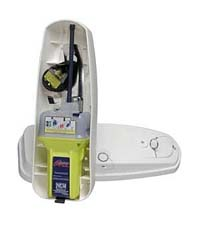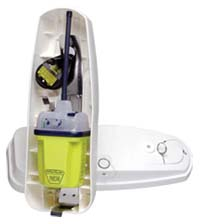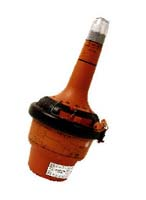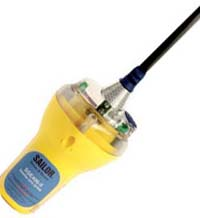The Cospas-Sarsat System provides distress alert and location information to search and rescue (SAR) services throughout the world for maritime, aviation and land users in distress. The System is comprised of:
- satellites in Low-altitude Earth Orbit (LEOSAR) and Geostationary Orbit (GEOSAR) that process and / or relay signals transmitted by distress beacons;
- ground receiving stations called Local User Terminals (LUTs) which process the satellite signals to locate the beacon; and
- Mission Control Centres (MCCs) that provide the distress alert information to SAR authorities.

The Cospas-Sarsat System can detect and locate distress beacons that operate at 406 MHz. Satellite processing of old analogue technology beacons that transmit at 121.5 MHz ended on 1 February 2009.
Cospas-Sarsat began tracking the two original types of distress radiobeacons in 1982. Specifically, these were:
- EPIRBs (Emergency Position-Indicating Radio Beacons), which signal maritime distress; and
- ELTs (Emergency Locator Transmitters), which signal aircraft distress
More recently, a new type of distress radiobeacon became available:
- PLBs (Personal Locator Beacons), are for personal use and are intended to indicate a person in distress who is away from normal emergency services
Cospas-Sarsat is an element of the Global Maritime Distress Safety System (GMDSS). Automatic-activating EPIRBs are now required on International Convention for the Safety of Life at Sea (SOLAS) ships, commercial fishing vessels, and all passenger ships, are designed to transmit to a Rescue Coordination Centre a vessel identification and an accurate location of the vessel from anywhere in the world.
ACR GlobalFIX 406 RLB-35 with Internal GPS

- FastACQ GPS engine acquires LAT/LON from a cold start better than normal GPS engines.
- FastACQ GPS is on for up to 25 minutes in the first 45 minutes of operation.
- Patented proprietary electronics package provides greater frequency stability for most accurate position through the LEOSAR satellites.
- 100m GPS position accuracy, optimum allowed by COSPAS-SARSAT.
- Only EPIRB available that provides a GPS acquisition test, a full functional self test of internal circuitry and battery voltage test.
- Category 1: Fully enclosed, high density, UV stabilized polyethylene bracket with hydrostatic release. Withstands extremely abusive environments. Hydrostatic release automatically employs EPIRB if vessel sinks to approximately 4m.
- Category 2: Universal Low Pro2 bracket; includes bulkhead and rail mount option.
- Transmits on 406 MHz (COSPAS-SARSAT) with your registered, digitally coded distress signal, and 121.5 MHz (SAR homing frequency).
Specification:
| Dimensions: | 441 × 121 × 89 mm |
| Weight: | 1,04 kg |
| Material: | Engineered high impact polymer/polyehylene bracket |
| Storage Temperature: Class 1: Class 2: |
-50°C to +70°C -40°C to +55°C |
| Operational Life: | In excess of 48 hours at: Class 1: – 40°C Class 2: -20°C longer in higher ambient temperatures |
| Modulation: | AM |
| Radiated Power: | 5 watts ±2dB (406 MHz) 50 mW ±3dB (121.5 MHz) |
| Waterproof: | 10 m |
| HRU: | H20 Hammar |
| Battery: Class 1: Class 2: |
lithium, 5 year replacement life (11 year storage) Non Hazmat; lithium, 5 year replacement life (11 year storage) |
| Deployment: Class 1: Class 2: |
Automatic, hydrostatic release Manual |
ACR SATELLITE2 406 RLB-32

Enjoy safety and security with a high tech 406 MHz EPIRB that meets all regulations and is fully approved worldwide. Life saving technology is now readily available. Unleash the power of the Satellite2 406 MHz EPIRB and turn that life threatening situation into a successful rescue story.
The Satellite2 406 Category I EPIRB is fully enclosed in a high density, UV stabilized polyethylene bracket with hydrostatic release that withstands extremely abusive environments, while the Category II Low Pro2 bracket offers bulkhead and rail mounting options.
- Automatically activated when out of bracket and in the water, or manually activated.
- Audio/visual indicators of active transmission.
- Floats upright with high visibility built-in strobe.
- Category I: Fully enclosed, high density, UV stabilized polyethylene bracket with hydrostatic release. Withstands extremely abusive environments. Hydrostatic release automatically deploys EPIRB if vessel sinks to approximately 4 m.
- Category II: Universal Low Pro2 bracket. Includes bulkhead and rail mount option.
- Transmits on 406 MHz (Cospas-Sarsat) with your registered, digitally coded distress signal, and 121.5 MHz (SAR homing frequency).
- Shore Based Maintenance or battery replacement due after use, OR 5 years from install date; not to exceed Battery Expiry.
Specification:
| Dimensions: | 368 × 108 × 92 mm |
| Weight: | 0.86 kg |
| Material: | High impact polycarbonate blend case/polyethylene bracket |
| Storage Temperature: | -40…+55°C |
| Operational Life: | In excess of 48 hours at -20°C longer in higher ambient temperatures |
| Radiated Power: | 5 watts ±2dB (406 MHz) 50 mW ±3dB (121.5 MHz) |
| Waterproof: | 10 m |
| HRU: | H20 Hammar |
| Battery: | Class 2, Non hazmat, lithium Replacement after use or 5 years from install date |
EPIRB Tron 40S

Approved according to ETS 300 066, IMO A662 / A695 (17) / A 810 (19), DIR 96/98 EEC, C/S T.001, RTCM (US Coast Guard), RMRS.
Specification:
| Dimensions: | 380 × Ø180 mm |
| Weight: | appr. 2.0 kg |
| Material housing: | Polycarbonate with 10% glass fibre |
| Antenna: | Built in, vertical polarisation, omnidirectional |
| Visual indication: | Built in Xenon flash and Test LED |
| Operating temperature:
operating option
|
-20…+55°C, Class 2
-40…+55°C, Class 1
|
| Operating life: | More than 48 hours at -20°C |
| Frequency: | 406.025 MHz ± 2ppm |
| Output power: | 5W ± 2dB |
| Digital message: | All protocols available |
| Data encoding: | Bi phase L |
| Stability:
short term medium term residual noise
|
≤ 10-9
≤ 10-9 ≤ 3×10-9
|
| Bitrate: | 400 b/s |
| Automatic release mechanism: | H-20 Hammar with Jotron special bolt |
| Battery: | JOTRON type number 97780, Lithium |
SAILOR SE-II and SGE-II Satellite EPIRBs

- GMDSS compliant
- Global distress alerting
- Satellite location
- Small and lightweight
- Fully enclosed housing
- 5-year shelf life
- Built-in GPS (model SGE-II only)
The SAILOR SE-II and SGE-II Satellite EPIRBs are satellite distress beacons designed to operate in conjunction with the Cospas-Sarsat international satellite search and rescue system.
For GMDSS compliance, the SAILOR 406MHz Satellite EPIRB has a slimline fully enclosed float free housing which allows self-testing of the EPIRB in question. The SAILOR EPIRB is also available with a quick release bulkhead mounting bracket for carry-off situations. Once removed from its mounting bracket, activation happens auto-matically by immersion of the water or manually by a protected push button on the rear of the EPIRB.
Specification:
| Weight: | 770 gr |
| Antenna: | internal omnidirectional |
| Strope light: | 0.75Cd light output minimum |
| Temperature:
Operating Storage
|
-20…+55°С (Class 2)
-30…+70°С
|
| Operating life: | 48 hrs |
| Frequency: | 406,025 MHz ± 1kHz |
| Output power: | 5W |
| Message formats: | Serialised, MMSI and radio call sign |
| Battery life: | 5 years storage |
Samyung SEP-406
SEP-406 EPIRB complies with CCIR, RTCM, COSPAS-SARSAT and GMDSS performance standards of IMO with transmitting frequency of 406 MHz. SEP-406 EPIRB, which is designed to be watertight and for ease of installation, have a hydraulic release mechanism to release automatically by water pressure.
- fully GMDSS compliant
- compact and light
- simple and safe to operate
- automatic float free housing
- totally watertight
- self-test
Specification:
| Dimensions: EPIRB Housing |
706 × Ø130 mm 685 × 191 × 160 mm |
| Weight: | 1,5 kg |
| Housing material: | ABS Plastic |
| Antenna: | Onmidirectional Whip Antenna |
| Strobe light: | 20 times per minute (min. 0.75 candela) |
| Temperature: | -20…+55°С |
| Operating life: | 48 hours at t -20°C 80 hours at t +20°C |
| Frequency: | 406,025 MHz ± 2ppm |
| Output power: | 5W ± 2dB |
| Data encoding: | Bi phase L |
| Stability:
Short term Medium term Residual noise
|
≤2 × 10-9
±1 × 10-9 ≤ 3 × 10-9
|
| Bitrate: | 400 b/s |
| Hydraulic release mechanism: | SHE-02 |
| Battery: | Lithium – 4 years service life |